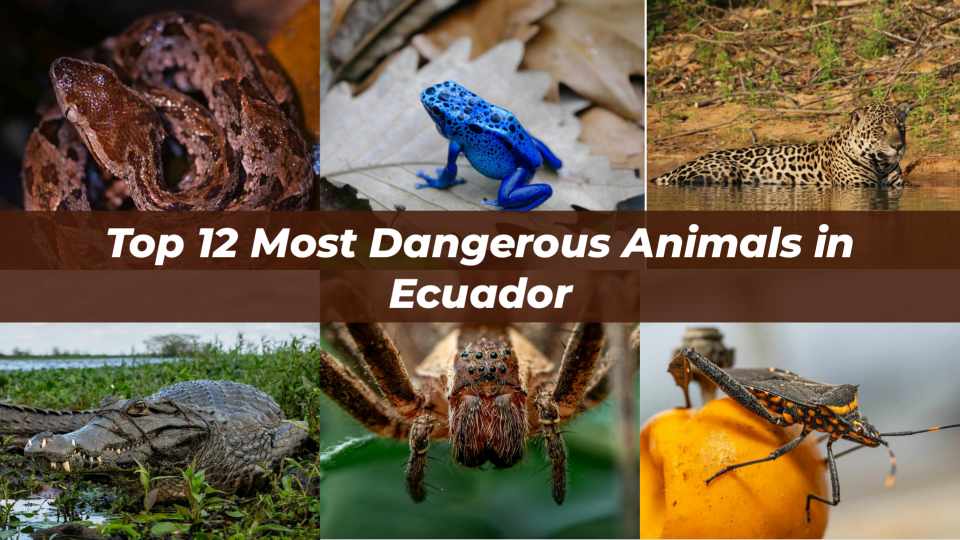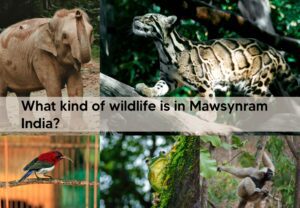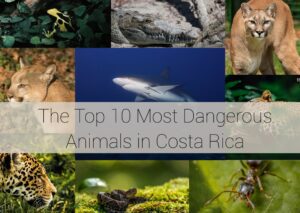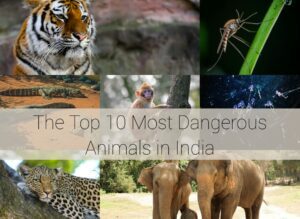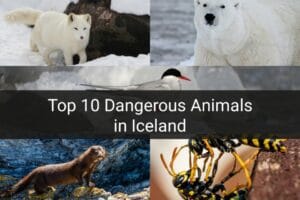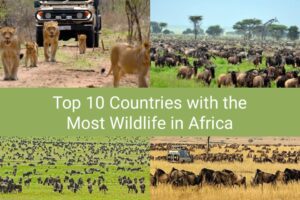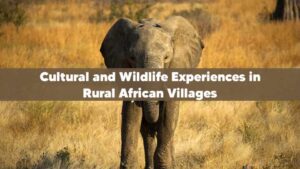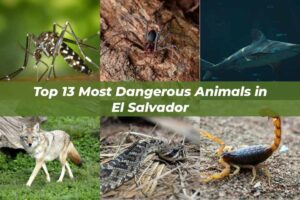Ecuador is a country with its own share of lush green rainforests and towering mountains. This type of habitat is ideal for some venomous or poisonous animals that are considered dangerous.
From predators on land to birds of prey or even ocean-dwelling creatures, there are many animals to watch out for in Ecuador.
In the article, we will look at the top 12 most dangerous animals in Ecuador. You will learn why these animals are considered dangerous and the habitats where they live.
Top 12 Most Dangerous Animals in Ecuador
1. Fer-de-Lance Snake

Scientific Name: Bothrops atrox
Habitat: tropical lowlands
Fer-de-Lance snakes, also known as barba amarilla, common lancehead, or mapepire balsain, are some of the most venomous snakes found in the Americas.
Trust me, you do not want to cross paths with this highly venomous pit viper responsible for the majority of snakebites in Ecuador. A bite from a Fer-de-Lance Snake can cause severe pain, swelling, and tissue damage and can lead to loss of life if untreated.
The worst part is that they are harder to spot in plain sight,making them masters of camouflage. They have a ground colouration that can be a combination of olive, brown, tan, gray, or yellow.
In the forest, Fer-de-Lance Snakes blends perfectly with brown leaves as they wait for unsuspecting prey or sometimes an unlucky traveller.
Fer-de-Lance Snakes primarily feed on small mammals like rodents and birds and other animals like frogs, lizards, smaller snakes, fish, centipedes, and tarantulas. Their venom is enough to subdue any of this prey, including larger animals.
Adult Fer-de-Lance Snakes can grow to a total length of about 30 to 50 inches. They also have a lifespan of 15 to 20 years in the wild.
2. Brazilian Wandering Spider

Scientific Name: Phoneutria
Habitat: forests, under logs, rocks or banana plants.
If you are not a fan of spiders, then you should pay attention to this spider, the Brazilian Wandering Spider. Also known as armed spiders or banana spiders, Brazilian Wandering Spiders, are one of the most venomous spider species in the world.
These spiders do not reside in a web; rather, they wander the jungle at night in search of prey. Like many other spiders, Brazilian wandering spiders hide under fallen logs, large rocks and dark places during the day. They are also known to hide in banana plants.
In some populated areas, Brazilian wandering spiders can hide in clothes, boots, houses, or any dark place during the day.
Brazilian Wandering Spider venom contains neurotoxins that can cause severe pain, loss of muscle control, and breathing problems and can become fatal to children.
How can you identify this spider in the wild? Simple, their posture. Brazilian Wandering Spiders have a defensive posture where they raise two front pairs of legs straight up. If you see any spider with this posture, do not disturb them.
3. Jaguar

Scientific Name: Panthera onca
Habitat: dense forest, rainforests and cloud forests
Another dangerous animal found in Ecuador is the Jaguar. These wild predators are the largest cat species in Ecuador and the entire Americas.
An adult Jaguar can reach up to 6 ft 1 inches in body length, and just like over cats the have sharp claws and teeth. The bite force of a Jaguar is strong enough to crush skulls and pierce the shells of turtles and tortoises.
Aside from having a strong bite force, Jaguars are good swimmers and will follow prey into the water to claim their prize. Sometimes they are known to wrestle and defeat crocodiles in the water.
The good news is that these apex predator rarely attack humans. Although they are unpredictable and silently stalking prey, they are also shy, and prefer to avoid humans.
Jaguars are most dangerous when they feel threatened, cornered. You can totally avoid Jaguar encounters by making noise like talking when hiking or in the forest to alert wildlife of your presence, so they can avoid you.
4. Bullet Ant

Scientific Name: Paraponera clavata
Habitat: lowland rainforests in trees, shrubs, and on the forest floor.
If you get stung by a bullet ant while on a trip, trust me, you will never forget that feeling. Bullet ants deliver the most painful insect sting in the world.
This medium-sized ant can reach 0.7 to 1.2 inches in length. It is important to note that they are called “bullet” ants for a reason.
Although the pain from a bullet ant sting is not lethal enough to be harmful to humans, the intense feeling can last for 12 to 24 hours.
If you visit a forest in Ecuador, be mindful of where you rest your hands or sit down in the jungle. It will be a big disaster if you get stung by a colony.
5. Black Caiman

Scientific Name: Melanosuchus niger
Habitat: slow-moving rivers, lagoons, and wetlands.
Another animal that can be harmful in Ecuador is the Black Caiman. These aquatic predators can grow up to 15 feet long, with powerful jaws and sharp teeth that can inflict serious injuries on prey.
Black caimans live in rivers, swamps, wetlands, and lakes where they hunt fish, monkeys, sloths, armadillos, pacas, coatis, and capybaras.
These creatures can pose a threat to humans if they disturb them in the water.
Avoid swimming in open waters at dusk or dawn when caimans are most active. Most importantly, do not feed them.
6. Poison Dart Frog

Scientific Name: Dendrobatidae
Habitat: humid, tropical environments
The Poison Dart Frog literally has the word poison in its name. These tiny frog species might look beautiful with different rainbow colouration like red, blue, yellow, and green.
Poison dart frogs have powerful toxins on their skin. This poison is strong enough to sicken or even lead to the death of a human if it somehow enters the bloodstream.
Their toxicity comes from the consumption of a diet consisting of toxic arthropods like specific ants and beetles.
If you spot a colourful-looking frog in the wild, never try to touch it. Toxins can enter your body through a cut or your mouth or eyes.
7. Harpy Eagle

Scientific Name: Harpia harpyja
The Harpy Eagle is a bird of prey found throughout Central America, South America and as far as Argentina. Harpy Eagles have large talons that they use to carry large prey like sloths.
This type of eagle is found in tropical lowland rainforests where they hunt wildlife like sloths and monkeys.
Although harpy eagles do not actively prey on humans, their large size, sharp beak and talons make them as dangerous as other animals on this list.
8. Giant Centipede

Scientific Name: Scolopendra gigantea
You do not want to mess with the Giant Centipede, aka the Amazonian giant centipede. These creepy crawlers are the largest centipede species in the world, with a length of about 12 inches.
Giant centipedes have a venomous bite which they use to attack prey. Their venom can cause serious pain, fever, and swelling.
It is a nightmare for people who have experienced their venom firsthand. They make scorpion stings look like a walk in the park.
They use this venom to overpower large prey like lizards, snakes, small birds, and even mice.
9. Electric Eel

Scientific Name: Electrophorus electricus
Electric Eels are another sea creature that animals or humans do not want to mess with. Found in the murky waters of Ecuador, electric eels can generate electricity and deliver shocks of up to 860 volts.
This is enough to stun or even kill a person. Electric Eels are mostly active at night, and they eat fish.
With an average length of 6 ft 7 inches, these sea creatures are known to grow as they get older.
If you ever find yourself in the Amazonian Rivers, be on the lookout for this shocking predator.
10. Piranha

Scientific Name: Serrasalmidae
Piranhas are another aquatic animals that can be dangerous due to their sharp pointy teeth. This freshwater fish species is found in the rivers on Ecuador.
Many movie adaptations of these creatures depict them as ferocious flesh eaters that can skeletonize prey in seconds.
In reality, Piranhas, have sharp teeth and can bite but can not strip flesh from prey in seconds. Unless a large schools of piranhas are involved which can be deadly, especially in the dry season when food is scarce.
We are kind of safe, because Piranhas do not primarily attack humans, although encounters are common.
11. Kissing Bug

Scientific Name: Triatominae
Kissing Bugs are also known as conenose bugs or vampire bugs. In the Americas, where they are found, locals call them different names like barbeiros, vinchucas, pitos, chipos and chinches.
This insect can transmit a parasite called Trypanosoma cruzi. This parasite causes Chagas disease, a life-threatening illness that can lead to serious heart and digestive problems years after the initial infection.
Kissing bugs are known to bite sleeping people on the face and then defecate near the bite. The parasite enters the body when the person unknowingly scratches the faeces into the bite wound.
In countries like Ecuador, they are found in rural areas with traditional houses made of mud, adobe, or thatch.
Provinces like Loja are an example, but the risk also exists in other areas. If you are staying in countryside or rural accommodations, make sure to check for bed nets and use them.
12. The Human Botfly

Scientific Name: Dermatobia hominis
Another flying insect that can be dangerous, especially to humans and other primates in Ecuador, is The Human Botfly.
The human botfly is also known as the torsalo or American warble fly. Adult botflies do not bite, but their larvae can develop under your skin.
Female botflies attach their eggs to mosquitoes or other blood-sucking insects so that when that insect bites a human or any other mammal, the botfly eggs hatch, and the tiny larvae burrow into the skin.
The larvae then develop under the skin, which can be very painful and itchy. Although serious infections can occur, it is more of a deeply unpleasant experience.
The best way to prevent the human botfly larvae infestation is to avoid mosquito bites. If you seem to have a central pore and movement after an insect bite, seek medical advice for proper treatment.
Do not try to squeeze it out aggressively since this can lead to serious infections if the larva breaks under the skin.
Bonus
Congratulations, you have read this article to this point. I have a bonus animal that is considered dangerous in Ecuador.
Green Anaconda
Scientific Name: Eunectes murinus
The Green Anaconda is popularly known by different names like the giant anaconda, emerald anaconda, common anaconda, common water boa, or southern green anaconda.
They are the largest and second longest snakes in the world, just slightly behind the python.
Green Anacondas are fast swimmers and apex predators. They are known to feed on large animals like tapirs, deer, capybaras, jaguars, and caimans.
Although they are not venomous snakes, green anacondas constrict and suffocate the prey to death before consuming them whole.
If you have watched the popular 1997 film titled Anaconda and its four sequels, you will be terrified of this snake. Although the size of the snake and its ability to swallow adult humans is somewhat exaggerated in the movies, they still pose a threat in their natural habitat.
Conclusion
Ecuador is one of the countries with the most wildlife due to the Amazon rainforest. Some of these animals are apex predators, while many others are masters of their domain.
In this article, we have provided a list of the top 12 most dangerous animals in Ecuador and a bonus.
It is important to note that while some animals may be considered more dangerous than others, they play a vital role in the ecosystem.
FAQs
What is the largest predator in Ecuador?
The largest predator in Ecuador is the jaguar. Jaguars are large and powerful big cats known to hunt large prey like caimans, deer, and capybaras.
Are there any dangerous animals in Ecuador?
Yes, there are dangerous animals in Ecuador. We have listed 13 in this article, ranging from venomous to poisonous and even powerful animals.
Are there tigers in Ecuador?
There are no tigers in Ecuador. The apex predators found in Ecuador are Jaguars.
What kind of animals live in Ecuador?
Over 300 species of mammals, 1,500 species of birds, 570 amphibians, and 450 reptiles have been recorded in Ecuador. These animals include the rare Andean spectacled bear, monkeys, marmosets, tamarins, sloths, deer, Andean foxes, llamas, anteaters, armadillos, agoutis, and capybara.

Hi, I’m Louis Ojibe, and I grew up around wildlife in Africa. I have always been fascinated by animals and nature across the world.
As a child, my parents used to take me to see wild animals like lions, elephants, gorillas, tortoises, and many others at our local zoo.

